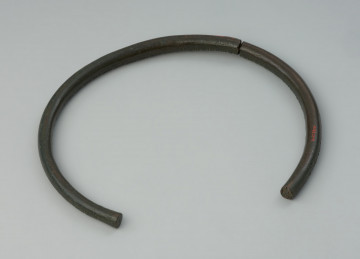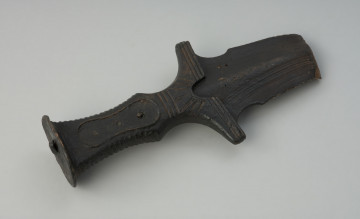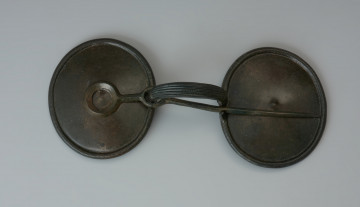
A rim necklace
around 600 p.n.e. — 400 p.n.e.
National Museum in Szczecin
Part of the collection: Bronze Age
This unique bracelet, called kidney-shaped because of the element connecting the two ends, was made of bronze by casting. That is confirmed by the pear-shaped remnants of the so-called overcasts left on the inside. Its surface is covered with an imposing decoration consisting of horizontal and vertical ribs and delicate diagonal lines and points. The rim is equally decorative. Bracelets were worn on both hands. However, in the case of large and heavy specimens, unique garters (leather or linen straps) were used to keep the decoration on the arm in the correct position. The relic comes from a hoard found in the middle of the 19th century, including other bronze ornaments and tools. In 1933, Mr von Grünberg donated the find to the collection of the museum in Szczecin. He claimed that the bronzes had been in his family for many decades. An article describing it for the first time: … rarity of the forms, the excellent state of preservation, and the high-quality craftsmanship allow the discovery from Wąsosz to be counted among the most remarkable Pomeranian hoards ... was published in 1934. Because of the war, the deposit was taken out of Szczecin deep into Germany in 1944. It returned to Szczecin collections only in 2009, under the Polish-German exchange of old archaeological collections. The kidney-shaped bracelets are concentrated in a large territory between the Vistula, Havel, and lower Elbe. The oldest specimens are dated to the 4th Bronze Age, and the youngest, and at the same time the most ornate, to the Hallstatt period D (approx. 600/550-400/450 BC), to which the presented specimen is related. Bracelets like this one are known in Poland only from four Pomeranian localities.
Dorota Kozłowska
Author / creator
Dimensions
the entire object: height: 4 cm, diameter: 10 cm
Object type
bracelet, body adornment
Technique
carving, punching, casting
Material
bronze
Origin / acquisition method
legal transfer
Creation time / dating
Creation / finding place
Owner
National Museum in Szczecin
Identification number
Location / status

around 600 p.n.e. — 400 p.n.e.
National Museum in Szczecin

around 900 p.n.e. — 750 p.n.e.
National Museum in Szczecin

around 1000 p.n.e. — 900 p.n.e.
National Museum in Szczecin
DISCOVER this TOPIC
Museum of King Jan III's Palace at Wilanów
DISCOVER this PATH
Educational path